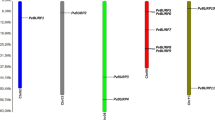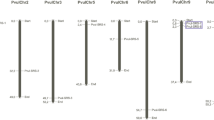Abstract
The aim of this study was to identify and characterize the C2C2-YABBY family of genes by a genome-wide scale in common bean. Various in silico approaches were used for the study and the results were confirmed through common molecular biology techniques. Quantitative real-time PCR (qPCR) analysis was performed for identified putative PvulYABBY genes in leaf and root tissues of two common bean cultivars, namely Yakutiye and Zulbiye under salt stress condition. Eight candidate PvulYABBY proteins were discovered and the length of these proteins ranged from 173 to 256 amino acids. The isoelectric points (pIs) of YABBY proteins were between 5.18 and 9.34 and ranged from acidic to alkaline, and the molecular weight of PvulYABBYs were between 18978.4 and 28916.8 Da. Three segmentally duplicated gene couples among the identified eight PvulYABBY genes were detected. These segmentally duplicated gene couples were PvulYABBY-1/PvulYABBY-3, PvulYABBY-5/PvulYABBY-7 and PvulYABBY-6/PvulYABBY-8. The predicted number of exons among the PvulYABBY genes varied from 6 to 8 exons. Additionally, all genes found included introns within ORFs. PvulYABBY-2, -4, -5 and -7 genes were targeted by miRNAs of five plant species and a total of five miRNA families (miR5660, miR1157, miR5769, miR5286 and miR8120) were detected. According to RNA-seq analysis, all genes were up- or down-regulated except for PvulYABBY-1 and PvulYABBY-6 after salt stress treatment in leaf and root tissues of common bean. According to the qPCR analysis, six out of eight genes were expressed in the leaves but only four out of eight genes were expressed in the roots and these genes exhibited tissue- and cultivar-specific expression patterns.





Similar content being viewed by others
References
Bailey TL, Williams N, Misleh C, Li WW (2006) MEME: discovering and analyzing DNA and protein sequence motifs. Nucleic Acids Res 34:W369–W373
Barbato C, Arisi I, Frizzo ME, Brandi R, Da Sacco L, Masotti A (2009) Computational challenges in miRNA target predictions: to be or not to be a true target? Biomed Res Int. doi:10.1155/2009/803069
Buyuk İ, İnal B, İlhan E, Tanrıseven M, Aras S, Erayman M (2016) Genome-wide identification of salinity responsive HSP70s in common bean. Mol Biol Rep 43:1251–1266
Caraux G, Pinloche S (2005) PermutMatrix: a graphical environment to arrange gene expression profiles in optimal linear order. Bioinformatics 21:1280–1281
Conesa A, Gotz S, Garcia-Gomez JM, Terol J, Talon M, Robles M (2005) Blast2GO: a universal tool for annotation, visualization and analysis in functional genomics research. Bioinformatics 21:3674–3676
Cong B, Barrero LS, Tanksley SD (2008) Regulatory change in YABBY-like transcription factor led to evolution of extreme fruit size during tomato domestication. Nat Genet 40:800–804
Dai M, Hu Y, Zhao Y, Zhou D-X (2007) Regulatory networks involving YABBY genes in rice shoot development. Plant Signal Behav 2:399–400
Eckardt NA (2010) YABBY genes and the development and origin of seed plant leaves. Plant Cell 22:2103–2104
Eldem V, Akçay UÇ, Ozhuner E, Bakır Y, Uranbey S, Unver T (2012) Genome-wide identification of miRNAs responsive to drought in peach (Prunus persica) by high-throughput deep sequencing. PLoS One 7:e50298
Eldem V, Okay S, Ünver T (2013) Plant microRNAs: new players in functional genomics. Turk J Agric For 37:1–21
Emanuelsson O, Brunak S, von Heijne G, Nielsen H (2007) Locating proteins in the cell using TargetP, SignalP and related tools. Nat Protoc 2:953–971
Eren H, Pekmezci M, Okay S, Turktas M, Inal B, Ilhan E, Atak M, Erayman M, Unver T (2015) Hexaploid wheat (Triticum aestivum) root miRNome analysis in response to salt stress. Ann Appl Biol 167:208–216
Fang Q, Xu Z, Song R (2006) Cloning, characterization and genetic engineering of FLC homolog in Thellungiella halophila. Biochem Biophys Res Commun 347:707–714
Golz JF, Roccaro M, Kuzoff R, Hudson A (2004) GRAMINIFOLIA promotes growth and polarity of Antirrhinum leaves. Development 131:3661–3670
Goodstein DM, Shu SQ, Howson R, Neupane R, Hayes RD, Fazo J, Mitros T, Dirks W, Hellsten U, Putnam N, Rokhsar DS (2012) Phytozome: a comparative platform for green plant genomics. Nucleic Acids Res 40:D1178–D1186
Guler NS, Saglam A, Demiralay M, Kadioglu A (2012) Apoplastic and symplastic solute concentrations contribute to osmotic adjustment in bean genotypes during drought stress. Turk J Bot 36:151–160
Guo AY, Zhu QH, Chen X, Luo JC (2007) GSDS: a gene structure display server. Yi Chuan 29:1023–1026
Gupta S, Malviya N, Kushwaha H, Nasim J, Bisht NC, Singh VK, Yadav D (2015) Insights into structural and functional diversity of Dof (DNA binding with one finger) transcription factor. Planta 241:549–562
Han H, Liu Y, Jiang M, Ge H, Chen H (2015) Identification and expression analysis of YABBY family genes associated with fruit shape in tomato (Solanum lycopersicum L.). Genet Mol Res 14:7079–7091
Hiz MC, Canher B, Niron H, Turet M (2014) Transcriptome analysis of salt tolerant common bean (Phaseolus vulgaris L.) under saline conditions. PLoS One 9:e92598
Horton P, Park KJ, Obayashi T, Fujita N, Harada H, Adams-Collier CJ, Nakai K (2007) WoLF PSORT: protein localization predictor. Nucleic Acids Res 35:W585–W587
Huang Z, Van Houten J, Gonzalez G, Xiao H, van der Knaap E (2013) Genome-wide identification, phylogeny and expression analysis of SUN, OFP and YABBY gene family in tomato. Mol Genet Genom 288:111–129
Hou J, Jiang P, Qi S, Zhang K, He Q, Xu C, Ding Z, Zhang K, Li K (2016) Isolation and functional validation of salinity and osmotic stress inducible promoter from the maize type-II H+-pyrophosphatase gene by deletion analysis in transgenic tobacco plants. PLoS One 11:e0154041
Juarez MT, Twigg RW, Timmermans MC (2004) Specification of adaxial cell fate during maize leaf development. Development 131:4533–4544
Kavas M, Baloğlu MC, Atabay ES, Ziplar UT, Daşgan HY, Ünver T (2016) Genome-wide characterization and expression analysis of common bean bHLH transcription factors in response to excess salt concentration. Mol Genet Genom 291:129–143
Letunic I, Bork P (2011) Interactive tree of life v2: online annotation and display of phylogenetic trees made easy. Nucleic Acids Res 39:W475–W478
Livak KJ, Schmittgen TD (2001) Analysis of relative gene expression data using real-time quantitative PCR and the 2(T)(-Delta Delta C) method. Methods 25:402–408
Lynch M, Conery JS (2003) The evolutionary demography of duplicate genes. J Struct Funct Genom 3:35–44
Mackay JP, Crossley M (1998) Zinc fingers are sticking together. Trends Biochem Sci 23:1–4
Pasquinelli AE (2012) MicroRNAs and their targets: recognition, regulation and an emerging reciprocal relationship. Nat Rev Genet 13:271
Peng X, Wu Q, Teng L, Tang F, Pi Z, Shen S (2015) Transcriptional regulation of the paper mulberry under cold stress as revealed by a comprehensive analysis of transcription factors. BMC Plant Biol 15:108
Sawa S, Watanabe K, Goto K, Liu YG, Shibata D, Kanaya E, Morita EH, Okada K (1999) FILAMENTOUS FLOWER, a meristem and organ identity gene of Arabidopsis, encodes a protein with a zinc finger and HMG-related domains. Genes Dev 13:1079–1088
Schluttenhofer C, Yuan L (2015) Regulation of specialized metabolism by WRKY transcription factors. Plant Physiol 167:295–306
Siegfried KR, Eshed Y, Baum SF, Otsuga D, Drews GN, Bowman JL (1999) Members of the YABBY gene family specify abaxial cell fate in Arabidopsis. Development 126:4117–4128
Suyama M, Torrents D, Bork P (2006) PAL2NAL: robust conversion of protein sequence alignments into the corresponding codon alignments. Nucleic Acids Res 34:W609–W612
Tamura K, Peterson D, Peterson N, Stecher G, Nei M, Kumar S (2011) MEGA5: molecular evolutionary genetics analysis using maximum likelihood, evolutionary distance, and maximum parsimony methods. Mol Biol Evol 28:2731–2739
Villanueva JM, Broadhvest J, Hauser BA, Meister RJ, Schneitz K, Gasser CS (1999) INNER NO OUTER regulates abaxial- adaxial patterning in Arabidopsis ovules. Genes Dev 13:3160–3169
Voorrips RE (2002) MapChart: software for the graphical presentation of linkage maps and QTLs. J Hered 93:77–78
Yamasaki K, Kigawa T, Seki M, Shinozaki K, Yokoyama S (2013) DNA-binding domains of plant-specific transcription factors: structure, function, and evolution. Trends Plant Sci 18:267–276
Yang Z, Nielsen R (2000) Estimating synonymous and nonsynonymous substitution rates under realistic evolutionary models. Mol Biol Evol 17:32–43
Yang ZF, Gu SL, Wang XF, Li WJ, Tang ZX, Xu CW (2008) Molecular evolution of the CPP-like gene family in plants: insights from comparative genomics of Arabidopsis and rice. J Mol Evol 67:266–277
Yang C, Ma Y, Li J (2016) The rice YABBY4 gene regulates plant growth and development through modulating the gibberellin pathway. J Exp Bot 67:5545–5556
Zhang YJ (2005) miRU: an automated plant miRNA target prediction server. Nucleic Acids Res 33:W701–W704
Acknowledgements
Ilker Buyuk received financial support from TUBITAK-BIDEB 2219- International Postdoctoral Research Fellowship Programme (Grant no: 1059B191600028) for his studies at Michigan State University in USA.
Author information
Authors and Affiliations
Corresponding author
Ethics declarations
Conflict of interest
The authors declare that they have no conflict of interest in the publication.
Electronic supplementary material
Below is the link to the electronic supplementary material.
Rights and permissions
About this article
Cite this article
İnal, B., Büyük, İ., İlhan, E. et al. Genome-wide analysis of Phaseolus vulgaris C2C2-YABBY transcription factors under salt stress conditions. 3 Biotech 7, 302 (2017). https://doi.org/10.1007/s13205-017-0933-0
Received:
Accepted:
Published:
DOI: https://doi.org/10.1007/s13205-017-0933-0




